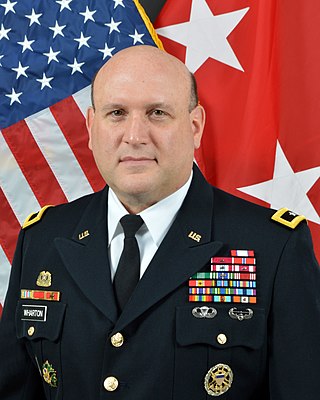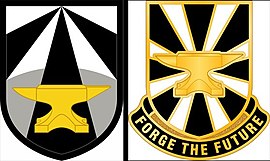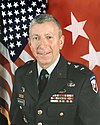
Eighteenth Air Force (Air Forces Transportation) (18 AF) is the only Numbered Air Force (NAF) in Air Mobility Command (AMC) and one of the largest NAFs in the United States Air Force. 18 AF was activated on 28 March 1951, inactivated on 1 January 1958, and re-activated on 1 October 2003. 18 AF is headquartered at Scott Air Force Base, Illinois.

The United States Army Aviation and Missile Command (AMCOM) develops, acquires, fields and sustains aviation, missile and unmanned aerial vehicles. AMCOM is primarily responsible for lifecycle management of army missile, helicopter, unmanned ground vehicle and unmanned aerial vehicle weapon system. The central part of AMCOM's mission involves ensuring readiness through acquisition and sustainment support for aviation systems, missile systems, and test, measurement, and diagnostic equipment (TMDE) throughout their life cycle. The command is headquartered at Redstone Arsenal in Huntsville, Alabama, has a 2019 "budget of more $3.7 billion, and a global workforce of more than 15,000 military and civilian employees".

The Combat Capabilities Development Command (CCDC) C5ISR Center, formerly the Communications-Electronics RD&E Center (CERDEC), is the United States Army information technologies and integrated systems center. CCDC C5ISR Center is headquartered at Aberdeen Proving Ground in Maryland, with activities at Fort Belvoir in Virginia and Joint Base McGuire-Dix-Lakehurst in New Jersey.

The U.S. Army Combat Capabilities Development Command Army Research Laboratory is the U.S. Army's foundational research laboratory. ARL is headquartered at the Adelphi Laboratory Center (ALC) in Adelphi, Maryland. Its largest single site is at Aberdeen Proving Ground, Maryland. Other major ARL locations include Research Triangle Park, North Carolina, White Sands Missile Range, New Mexico, Graces Quarters, Maryland, and NASA's Glenn Research Center, Ohio and Langley Research Center, Virginia. ARL also has regional sites in Playa Vista, California, Chicago, Austin, TX, and Boston.

The United States Army Tank-automotive and Armaments Command (TACOM), and its subordinate Life Cycle Management Command (LCMC), headquartered at the Detroit Arsenal in Warren, Michigan, is part of the United States Army Materiel Command (AMC).

The U.S. Army Combat Capabilities Development Command Aviation & Missile Center (AvMC), formerly known as the U.S. Army Aviation and Missile Research, Development and Engineering Center (AMRDEC), a part of the U.S. Army Research, Development, and Engineering Command (RDECOM) — now DEVCOM, is primarily a civilian organization tasked to provide research, development and engineering technology and services to support U.S. Army aviation and missile platforms. AvMC conducts research, promotes development, engineering and simulation laboratories and facilities used to develop and improve aviation and missile components, subsystems and systems.

The reorganization plan of the United States Army is a modernization (2015–2028) and reorganization (2006–2016) plan of the United States Army implemented (2006–2016) under the direction of Brigade Modernization Command. This effort formally began in 2006 when General Peter Schoomaker was given the support to move the Army from its Cold War divisional orientation to a full-spectrum capability with fully manned, equipped and trained brigades; this effort was completed by the end of 2016. It has been the most comprehensive reorganization since World War II and included modular combat brigades, support brigades, and command headquarters, as well as rebalancing the active and reserve components. The plan was first proposed by the Army's 34th Chief of Staff, Eric Shinseki, in 1999, but was bitterly opposed internally by the Army.

The U.S. Army Materiel Command (AMC) is the primary provider of materiel to the United States Army. The Command's mission includes the management of installations, as well as maintenance and parts distribution. It was established on 8 May 1962 and was activated on 1 August of that year as a major field command of the U.S. Army. Lieutenant General Frank S. Besson, Jr., who directed the implementation of the Department of Army study that recommended creation of a "materiel development and logistics command", served as its first commander.
A program executive officer, or PEO, is one of a few key individuals in the United States military acquisition process. As can be seen from the examples below, a program executive officer may be responsible for a specific program, or for an entire portfolio of similar programs.
The United States Army DEVCOM Ground Vehicle Systems Center (GVSC) (formerly United States Army Tank Automotive Research, Development and Engineering Center (TARDEC)), located in Warren, Michigan, is the United States Armed Forces' research and development facility for advanced technology in ground systems. It is part of the U.S. Army Combat Capabilities Development Command (DEVCOM), a major subordinate command of the U.S. Army Futures Command. GVSC shares its facilities with the United States Army Tank-automotive and Armaments Command (TACOM). Current technology focus areas include Ground Vehicle Power and Mobility (GVPM), Ground System Survivability and Force Protection, among others.

The United States Army Combat Capabilities Development Command Armaments Center (CCDCAC), or Armaments Center, headquartered at Picatinny Arsenal in New Jersey, is the US Army's primary research and development arm for armaments and munitions. Besides its Picatinny headquarters, the Armaments Center has three other research facilities, including Benét Laboratories. The Armaments Center works to develop more advanced weapons using technologies such as microwaves, lasers and nanotechnology. The Armaments Center was established in February 2019, when it was aligned with the United States Army Futures Command along with its senior organization, the United States Army Combat Capabilities Development Command. Armaments Center was called the U.S. Army Armament Research Development and Engineering Center (ARDEC).

The U.S. Army Edgewood Chemical Biological Center (ECBC) is the United States's principal research and development resource for non-medical chemical and biological (CB) defense. As a critical national asset in the CB defense community, ECBC supports all phases of the acquisition life-cycle ― from basic and applied research through technology development, engineering design, equipment evaluation, product support, sustainment, field operations and demilitarization ― to address its customers’ unique requirements.

The Communications-Electronics Command (CECOM) is a Life Cycle Management Command (LCMC) of the United States Army based at Aberdeen Proving Ground, Maryland, United States. It is one of four such commands under the Army Materiel Command (AMC), and is the Army's provider and maintainer of Command, Control, Communications, Computers, Cyber, Intelligence, Surveillance and Reconnaissance (C5ISR) capabilities.

United States Army Materiel Systems Analysis Activity (AMSAA) is an analysis organization of the United States Army. AMSAA's overall goal is to provide soldiers with the best U.S. Army materiel possible. AMSAA supports the U.S. Army by conducting systems and engineering analyses to support decisions on technology, materiel acquisitions, and the designing, developing and sustaining of U.S. Army weapon systems.

The United States Army Futures Command (AFC) is a United States Army command that runs modernization projects. It is headquartered in Austin, Texas.

Cedric Terry Wins is a retired U.S. Army general officer. Major General Wins was the last commander of RDECOM, in the U.S. Army Materiel Command, and the first commanding general (CG) of Combat Capabilities Development Command (DEVCOM), in the combat development element of U.S. Army Futures Command. In all, some 13,000 people work in some Science and Technology (S&T), or capacity for DEVCOM.

John Francis Wharton is a retired general of the United States Army. He was a career Army Logistician who also led US Army Science and Technology. In his last assignment served as the commanding general of the U.S. Army Research, Development and Engineering Command at Aberdeen Proving Ground in Maryland. Before that, Wharton served as the commanding general of U.S. Army Sustainment Command and Rock Island Arsenal, and as the senior commander for U.S. Army Garrison, Rock Island, Illinois.
Joint All-Domain Command and Control or JADC2 is the concept that the Department of Defense has developed to connect sensors from all branches of the armed forces into a § unified network powered by artificial intelligence. These branches include the Air Force, Army, Marine Corps, and Navy, as well as Space Force.
The US Army's Integrated Tactical Network (ITN) "is not a new or separate network but rather a concept"—PEO C3T. Avoid overspecifying the requirements for Integrated Tactical Network Information Systems Initial Capabilities Document. Instead, meet operational needs, such as interoperability with other networks, and release ITN capabilities incrementally.




























